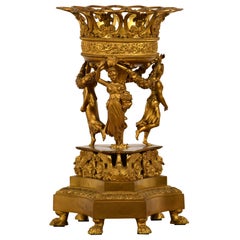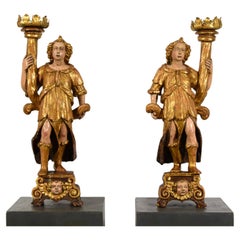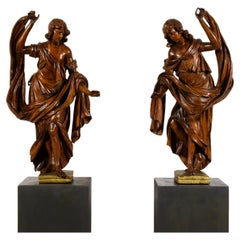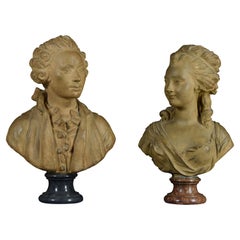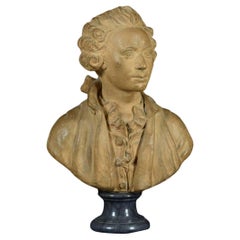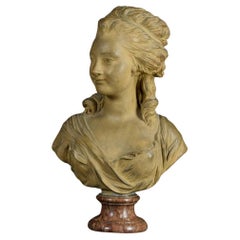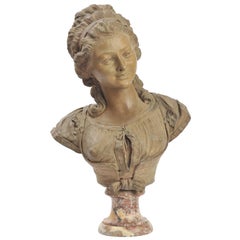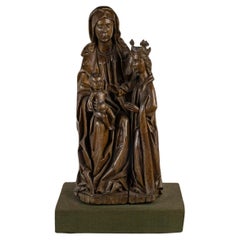Brozzetti Antichita Sculptures
to
1
14
5
8
1
1
1
4
3
1
1
1
5
5
5
5
5
14
14
7
7
Height
to
Width
to
14
14
14
1
1
19th Century, French Empire Gilt Bronze Centrepiece
Located in IT
19th Century, French Empire Gilt Bronze Centrepiece
This refined centerpiece stand was crafted in France in the early 19th century, during the Empire period, from finely chiselled an...
Category
Antique Early 19th Century French Empire Figurative Sculptures
Materials
Bronze, Ormolu
16th Century, Pair of Italian Lacquered and Gilt Wood Sculptures Torch Holders
Located in IT
16th Century, Pair of Italian Lacquered and Gilt Wood Sculptures Torch Holders
The pair of sculptures, in finely carved wood, lacquered and gilded, was born as a torch holder, and ...
Category
Antique 16th Century Italian Renaissance Figurative Sculptures
Materials
Wood
17th century, Pair of Italian Baroque Walnut Sculptures
Located in IT
17th century, Pair of Italian Baroque Walnut Sculptures
Measures: H 104 X W 60 X D 30 cm
The pair of sculptures was made in the Venetian area in Italy towards the end of the 17th ce...
Category
Antique Late 17th Century Italian Baroque Figurative Sculptures
Materials
Walnut
19th Century, Pair of Terracotta French Busts
By Augustin Pajou
Located in IT
Pair of terracotta French busts resting on circular marble bases, 19th century, signed on the back.
The refined pair of busts depicts a man and a woman who have been paired accord...
Category
Antique 19th Century French Louis XV Busts
Materials
Terracotta
19th Century, French Terracotta Bust and Marble Base with Nobleman
Located in IT
Terracotta bust depicting nobleman, marble base, 19th century, France
The refined bust depicts a nobleman dressed according to the fashion of the mid-eighteenth century in France. T...
Category
Antique 19th Century French Louis XV Busts
Materials
Terracotta
19th Century, French Terracotta Bust and Marble base with Noblewoman
Located in IT
Terracotta bust depicting noblewoman, marble base, 19th century, France
The refined bust, made of terracotta, depicts a noblewoman dressed according to the fashion of the mid-eighte...
Category
Antique 19th Century French Louis XV Busts
Materials
Terracotta
19th Century, French Marble and Gilt Bronze Centerpiece
Located in IT
19th Century, French Marble and Gilt Bronze Centerpiece
This particular centerpiece was made, in white marble and finely chiseled gilded bronze, in France between the end of the eigh...
Category
Antique 19th Century French Louis XVI Figurative Sculptures
Materials
Marble, Bronze
XIX Century, Pair of Venetian Gilt Bronze Fireplace Chenets in Baroque Style
Located in IT
XIX Century, Pair of Venetian gilt bronze fireplace Chenets in Baroque Style
This imposing pair of Fireplace Chenets in finely chiselled and gi...
Category
Antique Early 19th Century Italian Baroque Fireplace Tools and Chimney Pots
Materials
Bronze
18th Century Pair of French Gilt Bronze Sculptures on Marble Base
Located in IT
18th century pair of french gilt bronze sculptures on marble base representing Chinese figures
This particular and lovely pair of sculp...
Category
Antique Mid-18th Century French Louis XV Figurative Sculptures
Materials
Marble, Bronze
19th Century, Italian White Marble Sculpture by Pompeo Marchesi with Cupid, 1840
Located in IT
19th century, Italian white marble sculpture by Pompeo Marchesi with cupid, Italy, 1840
This valuable sculpture, made in white marble in 1840, is a work signed by Pompeo Marchesi....
Category
Antique 1840s Italian Romantic Figurative Sculptures
Materials
Marble
18th Century, Italian Bronze Sculpture with Venus Removing Her Sandal
Located in IT
18th Century, Italian Bronze Sculpture with Venus Removing Her Sandal
This bronze sculpture represents Venus as she takes off her sandal. Made in the neoclassical era in Italy, it consists of the bronze sculpture of the Greek goddess Aphrodite, Venus for the Romans. The naked goddess, getting ready for the bath, makes the very human gesture of loosing a sandal.
The left arm is raised, as if to compensate the position while maintaining the balance. Next to her, wrapped around a rocky spur, is a dolphin, an animal iconographically linked to the goddess because of his birth from the foam of the sea. The figure rests on a cylindrical and concave bronze base, with finely chiselled reserves. The bronze element is in turn resting on a africano marble cylinder with black of Belgium marble base.
Venus is one of the major Roman goddesses primarily associated with eros and beauty. It is traditionally understood as the equivalent of the Greek goddess Aphrodite, goddess of beauty, physical and passionate love, among the major deities of Olympus. His birth is due to a dramatic event: Uranus, Heaven, is mutilated by his son Cronus, who punishes him for the wrongs inflicted on his mother. The torn limbs of Uranus fall into the sea and fertilize the foam of the waves of the island of Cyprus. From the waves emerges in all its splendor Aphrodite. Since the 4th century, Aphrodite begins to be represented with characters more human and less heroic. Praxiteles with the 'Aphrodite Cnidia,' for the first time in the history of sculpture, depicts her naked, as she prepares to take a ritual bath.
From the Pressitele’s model descend the Capitoline Venus (Capitoline Museums of Rome) and the Venus de’ Medici (Uffizi Museum of Florence) accompanied by Eros on the back of a dolphin.
This vein also includes a subject frequently attested in the Hellenistic and then Roman Ages, with examples in bronze, marble and terracotta: the Aphrodite who fastens the sandal.
The luck that this type of representation had in the following centuries is demonstrated by the vast number of sculptures that represent it. In this bronze work the goddess resumes the position of Oplontis’s Naked Venus: here Venus holds an apple in her left hand, a reminder of her victory in the beauty contest in which she prevailed over Minerva and Juno by judgment of Paris. In our bronze instead, the hand seems to want to shake the apple, which however has not been molded. Perhaps the bronze is inspired by another work, such as the bronzes kept in the archaeological museum of Padua. Another example is the famous 'Venus in bikini" found in Pompeii, so-called because it depicts the goddess in the same pose, but with the breasts and hips covered by bands painted in gold.
The dolphin depicted next to it could be inspired instead to the Medici Venus...
Category
Antique Late 18th Century Italian Neoclassical Figurative Sculptures
Materials
Marble, Belgian Black Marble, Bronze
19th Century, Pair of French Porcelain Sculptures Depicting Cupid and Psyche
Located in IT
19th century, pair of French polychrome porcelain sculptures depicting cupid and psyche
The delicious sculptures, made of hand-painted porcelain in polychrome, in Strasbourg in th...
Category
Antique 19th Century French Baroque Porcelain
Materials
Porcelain
20th Century, Italian Sculpture by Helen König Scavini, Lenci Manufactory
By Lenci, Helen Scavini
Located in IT
Helen König Scavini, Lenci manufactory
"Nude of Woman", e.g. 1927-1936
Signed under the base "Lenci/Italy"
Glazed terracotta
sizes: H 70 cm x W front 83 cm (W back 55 cm) x D 55 cm
The important sculpture, realized in glazed terracotta, is by the famous Lenci Manufactory of Turin (Italy) on model by Helen König Scavini. Of remarkable dimensions, it represents a naked woman, covered of a single cloth to life, sitting with the legs flexed asymmetrically while it supports on the arms with the hands leaned to the plan. The woman has a hieratic expression, big eyebrow arches under which the ethereal eyes are half-closed; the open lips hide a hint of a smile. The loose hair is turned back with big waves on both the head and along the back. The staining of the glazing is on the tones of musky green, which contributes to confer to this woman the appearance of a nymph or a mythological figure.
Below the base is found, hand painted, the trademark of the manufacture "Lenci, ITALY". The brand Lenci was registered in Turin on 23 April 1919, sanctioning an activity undertaken some time before by Helen König, wife of the commercial agent Enrico Scavini. The origin of the word Lenci is still controversial today; the earliest bibliography says it derived from a endearment of Elena (Elenchen, as her father called her and that she, stunned him, pronounced Lenci) while the most recent one considers the acrostic Ludus Est Nobis Costanter Industria, perhaps invented by Ugo Ojetti or built as divertissement by the poet Ignazio Vacchetti (Alias Fantasio) on the endearment of Elena. The Lenci manufactory becomes a meeting point for artists and a forge of ideas for the development and realization of dolls and puppets, children’s furniture, and later also artistic ceramics. The first artists to take an active part in the enterprise were Giovanni Riva and Sandro Vacchetti, soon joined by other great names. The success of these felt dolls earned numerous awards to the Lenci Company during the international exhibitions in Zurich, Paris, Rome or Milan. However, the originality of Lenci’s creations was soon put to the test by numerous imitations. To cope with this type of competition, Lenci began to produce artistic ceramics, whose activity began in 1927. The ceramic figures became perhaps even more famous than the dolls in cloth. The subjects ranged from the famous "nudini", the chic little ladies and emancipated women, from fantasy characters to animals, from religious images to the most disparate vases and much more.
Many artists collaborated in the realization of the models, among which it is worth mentioning the already mentioned Sandro Vacchetti, artistic director of Lenci from 1922-1934, the same Elena König Scavini, Cläre Burchart, Lino berzoini, Giovanni Riva, Giovanni Ronzan, Deabate Theonesto, Giovanni Pietro Spertini, Marcello Dudovich, Gigi Chessa, Mario Pompei, Nillo Beltrami, Mario Sturani, Giulio Da Milano, Giovanni Grande, Ines Grande, Claudia Formica, Luigi Borione, Camillo Ghigo, Giuseppe Porcheddu, Gino Levi-Montalcini, Abele Jacopi...
Category
Vintage 1930s Italian Figurative Sculptures
Materials
Terracotta
$48,508 Sale Price
25% Off
17th Century, Italian Ancient Carved Stone Bust of Roman Emperor
Located in IT
17th century, Italian ancient carved stone bust of Roman Emperor
Measures: H 33 (with base) H 28.5 (sculpture only) x 25 x 7 cm.
The ancient bust, in ...
Category
Antique 17th Century Italian Classical Roman Busts
Materials
Marble, Stone
Related Items
19th Century French Terracotta Bust
Located in Brighton, Sussex
A good quality French 19th patinated terracotta bust of a classical lady, mounted on a Rouge marble sockel.
Category
Antique 19th Century French Baroque Busts
Materials
Terracotta
Oak Sculpture of Saint Anne, 16th Century.
Located in Saint-Ouen, FR
Oak sculpture of Saint Anne, 16th century.
Large oak sculpture of Saint Anne. Work from the Upper Rhine, Basel region. First third of the 16th century.
An arm is missing from the i...
Category
Antique 16th Century French Renaissance Figurative Sculptures
Materials
Oak
AMAZING MARBLE FIGURE OF THE MINOTAUR, 17th Century Baroque Style, Italy.
Located in Madrid, ES
MARBLE FIGURE OF THE MINOTAUR, 17th Century
Baroque Style, Italy.
Beige/grey marble. Minotaur on a rectangular "Rosso di Verona" base. H (without base) 81 cm.
H (without base) 81 c...
Category
Antique 17th Century Italian Baroque Figurative Sculptures
Materials
Marble
$41,920
H 40.16 in Dm 19.69 in
A 16th century carved marble sculpture of poseidon
Located in London, GB
This fine and imposing sculpture is an excellent example of 16th century Italian craftsmanship. The figure is stood on a raised, shaped rectangular base with a carved "dolphin" at th...
Category
Antique 16th Century Italian Renaissance Figurative Sculptures
Materials
Marble
Charming, 19th Century, Gilt Bronze Dogs
Located in Los Angeles, CA
Pair of expressive, 19th century, French, left and right, gilt bronze dogs mounted on octagonal, solid marble bases.
Category
Antique 1870s French Animal Sculptures
Materials
Marble, Bronze
AMAZING MARBLE FIGURE OF THE MINOTAUR, 17th Century Baroque Style, Italy.
Located in Madrid, ES
MARBLE FIGURE OF THE MINOTAUR, 17th Century
Baroque Style, Italy.
Beige/grey marble. Minotaur on a rectangular "Rosso di Verona" base. H (without base) 81 cm.
H (without base) 81 c...
Category
Antique 17th Century Italian Baroque Figurative Sculptures
Materials
Marble
$26,350
H 40.16 in Dm 19.69 in
Large 16th Century German Carved Basswood Saint Sebastian Sculpture
Located in London, GB
Antique Saint Sebastian Sculpture, Antique Saint Sebastian Statue, Antique Religious Sculpture, Religious Antique Sculpture, Antique Religious C...
Category
Antique 15th Century and Earlier German Renaissance Figurative Sculptures
Materials
Wood
$4,645
H 38.19 in W 9.26 in D 2.96 in
French 19th century White Carrara marble bust of La Comtesse Du Bary
By Augustin Pajou
Located in West Palm Beach, FL
An elegant and high quality French 19th century White Carrara marble bust of La Comtesse Du Bary, in the manner of Augustin Pajou. This charming bust is raised by a fine circular soc...
Category
Antique 19th Century French Busts
Materials
Carrara Marble
$23,800
H 28 in W 19.5 in D 9.75 in
Pair of 19th Century French Terracotta Busts of Children Signed E. Guillemin
By Émile Guillemin
Located in Dallas, TX
Decorate an office shelf with this cheerful pair of antique terracotta children busts. Crafted in Paris, France circa 1880, each subject features a child face sculpture standing on a black painted socle base. Each figure has wonderful facial expressions and nice details. Both artworks are signed on the back E. Guillemin with marks reading "Quai Jemmapes 6". The busts are in excellent condition with the original terracotta patinated finish.
Émile Coriolan Hippolyte Guillemin (1841-1907) was a French sculptor of the Belle Époque. He worked mainly in bronze and also made artwork subjects in terracotta. He studied under his father, the painter Auguste Guillemin, and under Jean-Jules Salmson. He showed work at the Salon of Paris from 1870-1899, and in 1897 received an honorable mention there. His sculptures incorporated themes inspired by the French revolution, Mediterranean mythology, and orientalist aesthetics. His oeuvre is reminiscent of other mid-18th century European bronze sculptors, including Jef Lambeaux, Marcel...
Category
Antique Late 19th Century French Belle Époque Busts
Materials
Terracotta
$1,300 / set
H 9.25 in W 4 in D 4 in
Italian 17th 18th Century Carved Giltwood Baroque Angel Head
Located in Buisson, FR
Beautiful giltwood angelhead.
Italy, circa 1650-1750
Weathered and small losses.
Measurement here below inclusive the wooden base.
H:18,5cm W:11cm D:11,5cm
Category
Antique 17th Century Italian Baroque Figurative Sculptures
Materials
Wood
$389 Sale Price
45% Off
H 7.29 in W 4.34 in D 4.53 in
Pair Of Late 19th Century Polychrome Terracotta Busts By Friedrich Goldscheider
By Goldsheider
Located in San Francisco, CA
A superb pair of late 19th century Austrian polychrome terracotta busts by Friedrich Goldscheider, both figures stamped to the reverse.
This pair of busts are in excellent original c...
Category
Antique 19th Century Austrian Art Nouveau Figurative Sculptures
Materials
Terracotta
$3,400 / set
H 13 in W 7.5 in D 5 in
19th Century Italian Terracotta Bust of a Classical Male
Located in Houston, TX
19th century Italian terracotta bust of a classical male.
This monumental antique Italian terracotta bust sculpture of a classical Roman male is a
well executed statement piece and...
Category
Antique 19th Century Italian Classical Roman Busts
Materials
Terracotta
